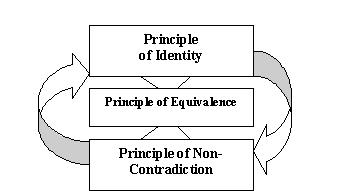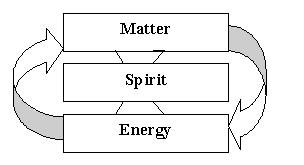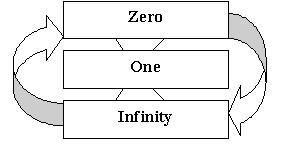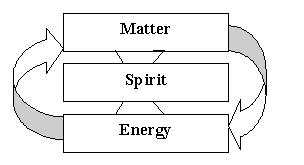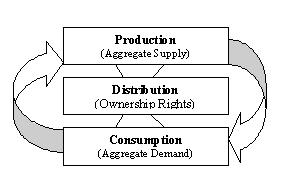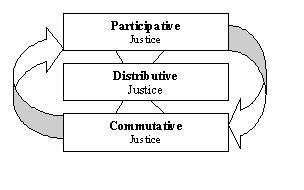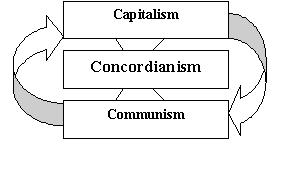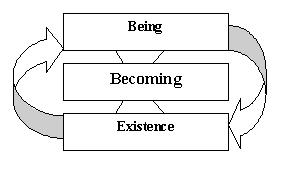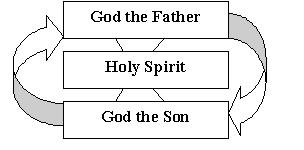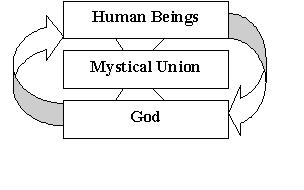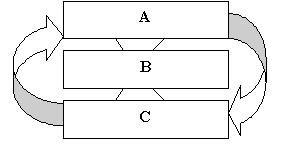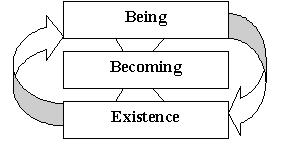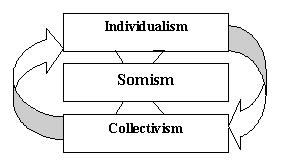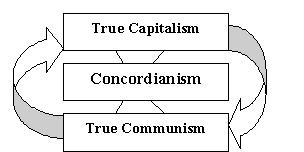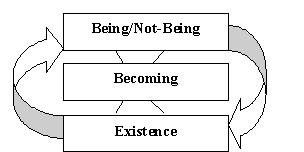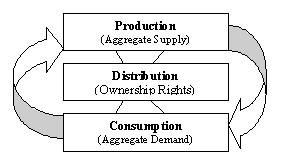The original publication is available at SSRN: http://ssrn.com/abstract=1695809 or http://dx.doi.org/10.2139/ssrn.1695809
Toward Relational Ontology:
From Matter to Spirit
Through Physics and Metaphysics
Carmine Gorga
President, The Somist Institute
December 2009
Abstract
On the basis of Alexander Marshack’s Roots of Civilization, the paper presents the essential steps in the development of a system of Relational Logic and a Theory of Complementary Knowledge as they have accrued from our early ancestors to the present. These methodologies help to transform Being, Becoming, and Existence into concepts of Relational Ontology. In the process, the paper discovers that the transition from matter to spirit is a logical necessity both in physics and in metaphysics.
Brief Bio
Carmine Gorga is a former Fulbright scholar and the recipient of a Council of Europe Scholarship for his dissertation on “The Political Thought of Louis D. Brandeis.” Using age-old principles of logic and epistemology, as well as mathematics employed by modern engineers and scientists, in a book and a series of papers Dr. Gorga has transformed the linear world of economic theory into a relational discipline in which everything is related to everything else—internally as well as externally. He was assisted in this endeavor by many minds, notably for twenty-seven years by Professor Franco Modigliani, a Nobel laureate in economics at MIT. The resulting work, The Economic Process: An Instantaneous Non-Newtonian Picture, was published by the University Press of America in 2002 and will be republished in an expanded edition in 2010. For reviews, see http://www.carmine-gorga.us/id18.htm. During the last few years Mr. Gorga hasconcentrated his attention on methodology and its application of to a variety of disciplines. The result is a new system of thought that he likes to identify as Relationalism.
In a culture in which Existence reigns, Dunash ben Labrat sings:
Do not sleep! Drink old wine,
Amidst myrrh and lilies, henna and aloes,
In an orchard of pomegranates, palms and vines,
Full of pleasant plants and tamarisk;
To the hum of fountains and the throb of lutes,
To the sound of singers, flutes and lyres.
In a culture in which Being reigns, Dante sings:
fatti non foste a viver come bruti
ma per seguir virtute e canoscenza.
(you were not made to live like brutes
but to follow virtue and knowledge.)
In a culture in which Agnosticism reigns, Lorenzo Il Magnifico sings:
Chi vuol esser lieto sia
Del doman non c’e’ certezza.
(If you want to be happy, be happy
Tomorrow is not certain.)
Metaphysics, with ontology at its core, has the ability to influence our lives in a pervasive and deep way. And yet, metaphysics is in disuse today. The focus of this paper is on the recognition that, without metaphysics, it is impossible to answer in an acceptable fashion three fundamental questions about knowledge: why do we know, how do we know, and what do we know.
The paper attempts to demonstrate that metaphysics is in disuse today, not because the modern philosophical mind finds something inherently objectionable in the subject, but because we have neither a widely accepted system of logic nor a widely accepted theory of knowledge on which to base the study of metaphysics. Traditional systems of logic and the tools of epistemology have been tacitly superseded by more adequate tools, which however have not yet been systematically gathered to form new and powerful tools of analysis. The paper therefore outlines a new system of logic, Relational Logic, and a new epistemology, the Theory of Complementary Knowledge in order to answer the question “How do we know.” It is on the basis of these two sets of tools of the human mind that the paper proceeds to outline a new understanding of ontology, which this writer likes to call Relational Ontology. This understanding is obtained from physics as well as from metaphysics.
The fundamental premise of the paper is that Relational Logic, Complementary Knowledge, and Relational Ontology are three essential pillars for the formation of a possible structure of modern philosophy, a philosophy that on the basis of experience and physics reaches the realm of metaphysics. Upon consideration, do not principles of logic and tools of knowledge by their very nature already belong to a world that automatically goes beyond pure physics? Since these three elements are so inextricably related to each other, and since ontology is a closely knit array of ultimate relationships, this writer proposes to call the resulting philosophical system Relationalism.
I. Why Do We Know
Metaphysics is used to be described as the knowledge of being.
The central reason why metaphysics currently is not a preeminent concern in philosophy is due to its traditional concentration on one entity: being. Were we to stop at the mere enunciation of it, we might attain the holistic wisdom of Eastern mystics, who concentrate on “OM” — and are happy to surround this symbol with the richness of sounds, smells, and colors. As opposed to mysticism, however, the intense tradition of both Eastern and Western philosophy impels us to break things (words and worlds) apart and analyze each component part one by one. Thus the dance of meanings starts.
Dissatisfied with symbols, thinkers who are called to go deep into the significance of things, write down “being” and maintain that being is a word. As soon as the human mind indicates that being is a word, this simple mental operation separates ourselves from being and being from us. We objectify both being and the word, and we run into all sorts of mental difficulties. We automatically become incapable of putting the two entities together again. In fact, rather than reducing the two to one, the number of entities involved in this objectification of being has, perhaps without our awareness, increased by at least one unit: being, the word, and me (us?). When, hoping to go to the bottom of the issues, we write “being is,” we compound the difficulties because, without having resolved the problems inherent to term logic, we pass into the realm of propositional logic. We thus enter the domain of logical positivism — and there we have remained prisoners for more than a century. Do parallel lines meet? The answer is negative, if we remain within the realm of Euclidean geometry. But as soon as we enter the realm of non-Euclidean geometry, parallel lines meet!
Clearly, there is no safety in individual propositions.1 No matter how complicated we make them, no matter how twisted or straightforward we make them, no matter indeed with which syllogistic figure we group them and analyze them, individual propositions do not lead to certain communication and understanding. Individual propositions cannot provide any guidance to our thought processes. Safety lies in the realization that propositions — tinted as they are with their rush to judgment — make any sense only in relation to systems of thought. This is not an assumption made only on the basis of the history of geometry and economics. It is equally valid in ontology. By writing “being is” without first developing ontology into a system of thought, the difficulties of understanding “being” become insurmountable, as demonstrated by the history of this search — which, strangely enough, was initiated both in the West and in the East at approximately the same time, about 2,500 years ago. The search has led to two major schools of thought: one, led by Parmenides and Plato, might be classified as Absolute Ontology; the other as Negative Ontology. The latter has been led by Buddha in the East and Plotinus in the West. (Placed in this context, Eastern and Western philosophy, rather than diverging, as too often assumed, can be seen as converging on the same path: the search for the meaning of being.)
Absolute Ontology
Being. No matter how hard the human mind has tried, centuries of effort by the keenest people on earth have so far come to naught. No sooner does one advance an explanation, a valid objection is raised against it. So the search starts anew. The basic problem is that the word “being,” even when extended into the proposition “being is,” is locked into a system of absolute ontology in which there is no room for anything else but “being.” Attempts to explain this word in terms of such other entities as essence, substance, or existence, by shifting the burden on to the meaning of these terms, have only compounded the difficulties — which are painstakingly described in the magisterial analysis of Etienne Gilson in his Being and Some Philosophers (1952).
In the proceeding we will examine why these efforts were destined to fail. At the moment, on the basis of such long and consistent history, we need only conclude that there is no way to escape the limitations of the metaphysical problem as construed at present, except by getting out of its closed system. If we do that, we extend the application of Gödel’s Incompleteness Theorem to metaphysics and we heed both its explicit and implicit message.
At first sight, this decision might appear to be a radical departure from traditional scholarship. Yet, it is a mere acceptance and explicit ratification of the reality that philosophy has abandoned the metaphysical project as construed in the past. This approach is also a recognition of the value of what — especially but not exclusively — Eastern philosophers have done.2 They have created a system of thought that might be classified as Negative Ontology.
Negative Ontology
Rather than saying what being is, some philosophers like to start the discourse from what being is not. Christmas Humphreys, the author of a comprehensive book entitled Buddhism (1964, pp. 127-128), explains that to understand being “Only a negative is possible, for we can conceive the Infinite only as the not-finite, as the word implies. All possible description is adding predicates to the All, which is either absurd for redundancy or, by exclusion, a limitation of the All.”
With that restraint, it appears that the discourse has advanced at least an inch and that the approach has added to our sum total of knowledge, but we still have no better understanding either of being or not-being. No sooner does one state that being is “not such and such,” another philosopher finds a logical contradiction in the proposition.Some deny the very existence of not-being.
And there we stand today: an impasse in the schools of thought that address metaphysics. The impasse is so deep and so vast that it has led to the abandonment of metaphysics. Yet, is it necessary to repeat that without an understanding of metaphysics it is doubtful we can ever have a proper understanding of the world. It seems appropriate, therefore, to assume that we need a new start.
A Fresh Start
This paper is an attempt to make metaphysics suitable to the modern mind through the creation of a new framework of analysis that might be described as Relational Ontology. To reach this aim, we will transfer the roots of the problem from philosophy to psychology and anthropology and we will start the discussion from the proposition that the fundamental problem of knowledge is a problem of consciousness. The assumption is that without understanding the problem of consciousness we cannot extricate ourselves from the sea of existence in which we are enmeshed.
Inspired by Colin McGinn (e.g., The Problem of Consciousness 1991; The Making of a Philosopher, 2002), this paper starts the analysis of the problem of knowledge from a basic word, namely the word “I” and suggests — as a working hypothesis — the following definition for this entity: I am consciousness.
This is a good start, provided we immediately take care of its inner weakness. By itself, it is a bombastic statement, which leads to solipsism, and there the discourse ends. To eliminate this pitfall, we have to purge the statement of its inherent structural weakness, namely, we have to open it up — from the start — to the outside world. Upon reflection, we realize that the solution of our problem thus ramifies into the need to surmount three difficulties: we have to define “I,” we have to define the meaning of “am,” and we also have to define the meaning of consciousness. We are back in the vineyard of philosophy.
Consciousness is the separation of a sensation from its memory. I become aware of a sensation as soon as something somehow affects me. But by the moment I notice that something, the sensation has already passed away. What I am left with is the memory of that particular sensation — even though some aspects of the same sensation may still continue. Pace Locke and Hume, it has to be specified both that the focus of our attention is on the memory of this sensation and that the particular sensation does not need to be based on something physical either: logic, love, a spirit, a dream, an angel, Pegasus, and Emma will also do it.3 They can all give us a “sensation” of something. Looking at the situation prospectively, we can also say that — paceBerkeley — consciousness is the integration of memory and sensation. Consciousness thus is neither memory nor sensation, but a third entity, the integration of the two — and it certainly is not a physical entity. This definition of consciousness does not distinguish us from the beasts, but that distinction is not essential at this stage of our discussion.
The fact that we are, and presumably we have always been conscious entities, namely that we have the innate ability to separate memory from sensation and manipulate memories, contains the reason why we know what we know — as distinguished from the reason why we are what we are. Granted, this is a low-level near-mechanical explanation. But eschewing a premature concern for the grandiosity of cosmology, eschatology, or teleology, we are free to proceed in our investigation. By further defining memory as a dematerialized sensation, we are confirmed that we have entered a field that is beyond physics.
The real difficulties in the statement “I am consciousness” lie in the definition of “I” and the definition of “am.” As soon as we reach this realization, we implicitly admit that without knowledge of metaphysics we cannot define even such apparently simple entities as “I” and “am.” Indeed, this realization is spur enough for the reconstruction of metaphysics. The best place to enter the argument is to place ourselves, not in the position of modern philosophers, but in the position of our earliest ancestors. How did they set things in motion? We will see that the immediate problem is one of how do we acquire knowledge rather than one of metaphysics.
The assumption that I hope to validate is that our ancestors gained their understanding of the world inch by inch on the strength of a system of logic and tools of epistemology that they developed as they went along. This is not work of fancy. The line of progress followed by our early ancestors can be rather confidently reconstructed by examining the brilliant investigation of Alexander Marshack, which he reported in The Roots of Civilization (1982).
It might be useful to specify immediately that what is here treated as an inevitable sequence of events might have occurred all at once — many times, perhaps, and undoubtedly through many trials and errors. In other words, the differentiation between logic and epistemology is something that we have to make for clarity of exposition. It might not have existed in the minds of the earliest practitioners of logic and epistemology, which of course does not mean that they did not distinguish between the various tools they were handling. The situation is akin to that of putting on a tie and, as Professor Paul A. Samuelson, a Nobel laureate in economics, once magically explained, describing the process by which one puts the tie on. Doing is an incredibly compressed unit of real life. It is also immaterial whether our ancestors used tools of epistemology before they used tools of logic — or vice versa. They might well have followed either approach.
II. How Do We Know
From a superficial reading of today’s stock of knowledge, it would appear that we cannot rely on anything we know, that knowledge at best forms random globs, and that there are no rules in the process of its acquisition. The certainty that Descartes gave us with his Discourse on the Method (1637) has disappeared. Induction turned out to be too complex a method of analysis. We are indeed, as John Lukacs points out, At the End of an Age (2002). It seems that we no longer have any reliable method to assist us in our thinking process. Indeed, as soon as someone has come forward brave enough to propose a method — even simply a paradigm or framework of analysis — not much time has elapsed before someone else has found a hole in the reasoning. At the moment, the last word seems to belong to Feyerabend, the cat that chased and ate its tail, who in a telling title declared himself “Against Method” (1975). It would appear that Lewis Carroll’s Master of Words is indeed in charge. From much of what is said, especially but not exclusively for and against deconstructionism, it would appear that anything goes.
Not so. An analysis of systems of logic and tools of epistemology reveals that there are stringent rules that guide our reasoning. Let us quickly review them.
The Theory of Knowledge
We identify each item within the sea of existence, and we acquire knowledge about it, only on the strength of a theory of knowledge. Since the topic is that important, the field is replete with controversy. We shall try to eschew the controversies by being concerned primarily with a system of tools, which compose the outline of a theory of Complementary Knowledge.
The Tools of Epistemology
To simplify to the extreme, it is possible to suggest that while officially, so to speak, we still pay outward respect to the ten Aristotelian categories of thought, in practice we have abandoned them as useful tools of epistemology. It is sufficient to read any writer on methodology today — from Mises to Popper, from Samuelson to Friedman, from Kuhn to Lakatos — to realize that the transition to the use of different tools of analysis has indeed occurred silently. It is further possible to suggest that, while this literature (which, tellingly, is mostly gathered under the heading of philosophy of science) is involved in enormous controversies of its own as to the meaning and functionality of each theory, in practice, with minor differentiations, we all know and use a few basic tools that the theory of knowledge has created over the millennia.
Following a progressive level of abstraction, without paying any attention to their own subtle subdivisions these tools are: names, ideas, concepts, theories, and systems of thought — and, for some technical intrinsic advantages of their own, today we might want to add computer models to this list. Any “thing” that comes under our observation — be it a specific baby, a specific tree, or a specific subatomic particle — enters the field of our knowledge as soon as we give “it” a name. The “word” is indeed the alpha and the omega in the process through which we acquire knowledge of anything. This process is complex, but its outline is well known and it does not need to be highlighted here. It is the next stage that bears a moment of our attention: how are names gathered into ideas. It would be cumbersome to carry in our brain the myriad of names that correspond to the myriad of individual “things.” Thus, following a large variety of factors, we group them into a more abstract container that we call ideas: with the sum of all particular babies, we acquire the idea of baby. And since ideas are equally immensely numerous, we group them into concepts, and concepts into theories, and theories into systems of thought.
One specific example might be useful. In economics, we pass from the name of this oak to the idea of oak tree, to the concept of investment (in wood), to the complementary theory of hoarding and investment, and — tolerating many non-essential elisions — we end up with a system of economic thought. An important caveat much open to discussion is in order: Contrary to the entire train of thought pursued in the last few centuries in which empiricism has dominated our thought processes, facts are not tools of epistemology. Facts are infinite; and they are outside our consciousness. They enter our consciousness as soon as we give them a name and we gradually construe a theory about them. Facts are not tools, but products. Thus facts are not the beginning, but the end of epistemology. Facts are what the theory of knowledge attempts to understand and to explain. Outside of a theory, there have been cases of “facts” that turned out to be nonexistent: see phlogiston; and conversely, there are facts such as hoarding that are not taken into account by mainstream economics because they do not enter its mathematical models. To insist on the point: There are no facts, until we give them a name. And then, as if to prove that we do not create the world, there is no certainty about the existence of these facts until we have proved their existence through a theory. And then, of course, the theory may be proved wrong in the course of time. Thus the dance of meaning continues forever and ever, until man is alive.
Once we recognize the existence of these tools of epistemology, we can integrate them into a theory of knowledge whose bare outline is as follows.
The Bare Outline of a Theory of Complementary Knowledge
If all true knowledge is not linear but can ultimately be reduced to a complex array of systems of thought, it means that we can set each one unit of knowledge as equal to the number one. The sum of the component parts of that unit then must be equal to one. When possible, to simplify to the extreme the number of components can be reduced to two.
At that point in the reasoning, it might be possible to determine that the two components, rather than being in opposition to each other — as most often they appear to be when they are analyzed in isolation from each other; and, indeed, thanks to Benedetto Croce’s Logic as the Science of Pure Concept (1909), even when they are in clear opposition to each other — the two components are instead revealed to be essential parts of the same unit of knowledge. They are complementary to each other.
At that instant, much controversy might be avoided simply by the use of the double conjunction: and also. There are innumerable such cases in our intellectual life. We will have occasion to observe some of those that occur in the field of metaphysics: the most evident is being and not-being. As pointed out above, before reaching that point we need to equip ourselves with a manageable theory of logic.
To insist on the point, systems of logic and theories of knowledge are so interlaced that one cannot speak of one without the assistance of the other. Nor does one come before the other. And yet, for clarity of analysis they need to be kept separate from each other.
A System of Relational Logic
The theory of knowledge, as we have seen, allows us to identify items (such as trees) and acquire (economic) knowledge about them; principles of logic allow us to isolate items from the sea of existence, and to keep them separate from each other.
Even though the system of classical logic, the earliest system of logic about which we have a written record, was codified by Aristotle, we have to realize that our Cro-Magnon ancestors — living some forty-thousand years ago, if not earlier — investigated the world around them through a full-fledged system of logic.
The evidence is overwhelming. This is what they did. As Alexander Marshack points out, they put notations on bones and other objects of durable material that today are collected in innumerable museums throughout the world. Clearly, our ancestors were counting something. Counting, no less — an act which, upon consideration, is so complex because it turns out to be filled with memory (or fear of losing it), imagination, and hope. Let us suppose that they were counting the number of salmon going upstream. And let us not even ask why they would spend their time doing a thing like that. One salmon, one notch, on one bone. The operation is so familiar to us today that we do not stop to think of the many issues involved in it. Let us reflect on that central discovery made by Marshack.
Whether by trial and error or by one stroke of genius (repeated anew many times by many minds over many millennia?), before counting anything our ancestors took firm decisions regarding three fundamental matters of methodology. First, they made sure that “this” bone contained information related to salmon — and salmon only. Our ancestors thus discovered, and perhaps in the same breath made use of, the principle of identity: a term must be identical to itself throughout the discourse.
Clearly, this principle — and the other principles observed below, just as much as the very name salmon — did not exist in anything or anyone outside the innate creativity of our ancestors. And however described, especially in its oral version, it certainly was not a physical element. Strictly speaking, we can therefore classify this principle as a metaphysical element. Unavoidably. (What was the hard wiring in their brain and the programming that allowed our ancestors to make such decisions — and the similarity of the hard wiring and programming in the brain of their interlocutors — are fascinating investigations that go beyond the scope of this paper. Also, how did, mechanically, our ancestors create this principle? Were they aware that they were creating such a principle? Were they aware of its importance? All neural, genetic, psychological, hermeneutical, sociological, teleological, or philosophical issues involved in the discovery of this principle are interesting to analyze and to discuss. But they do not change three simple facts. The principle of identity was discovered in the very ancient past, it is still used today by us all, and it belongs to a world that is not physical in any sense of the word physical.)
And how were our ancestors sure that such a notation was related to the salmon — and the salmon only? They were so sure because they used a different bone for notations concerning the appearance of the moon. By stating that this bone related to the salmon, they were implicitly or explicitly saying: “This bone does not relate to the moon.” They were therefore applying the principle of non-contradiction. They could be sure that this bone belonged to notations regarding the salmon, because it did not relate to notations regarding the moon — or any other object under the sun. (Pace Hegel, unless we want to fall into the abyss of his “inverted world,” we must recover the use of the principle of non-contradiction. If we do not, we enter the night in which, as he said, “all cows are black.” And much worse than that. We enter a totalitarian world in which the speaker has the final say. Why? Because without the principle of non-contradiction one cannot prove anything — hence one cannot disprove anything.)
This is basic complementary knowledge (of salmon and moon).
Our ancestors also did something of even deeper value. In the process of setting their method of gathering, recording, and manipulating knowledge, they implicitly or explicitly discovered and gave expression to the following tight relationship:
This Notation = The Word Salmon = The Fish I See Swimming.
And they had great faith in this relationship, which would eventually be called the relation of, or principle of, equivalence. Decoding what our ancestors did, they used a complete system of logic to help them gain their understanding of the world. Let us call it Organic Logic, or perhaps better, Relational Logic. The principle of equivalence was inextricably flanked by the principle of identity on one side and the principle of non-contradiction on the other. To note the fertility of this system of logic, let us quickly see how it led our early ancestors to the discovery of the power of syllogisms, mathematics, and geometry. On a cold winter night, by the light of a roaring fire, they took two tablets and they said:
If tablet A contains knowledge about salmon,
And if tablet B contains knowledge about salmon,
Tablet C that summarizes A and B contains knowledge about salmon. (This is the first time this writer has noticed the root of summarize.) This reasoning allowed them to store one tablet, rather than two; it expressed perhaps the first syllogism; and it also led to the invention of mathematics. In this fashion: If (Five fingers = Five digits/notations = Five salmon) and/plus (Five fingers = Five digits/notations = Five salmon) then Ten fingers = Ten digits/notations = Ten salmon.
Following the same reasoning, they put two bones/tablets together and they began to observe the relationship of lines and angles they formed. Thus they invented geometry.4
***
A Reassuring Vignette. Before proceeding, it might be good to take a moment to reassure ourselves of the need to distinguish between the tools necessary to gain knowledge and the content of our knowledge. Without the inherent participation of such metaphysical tools as the principles of identity, non-contradiction, and equivalence, in our process of acquiring knowledge we would not be able to separate “reality” from its description/name; we would not be able to separate one item from another in the sea of existence; we would not be able to see ourselves as separate entities from the sea of existence. Instead, we would only accumulate such powerless verbiage as this: The moon is the salmon; the salmon is the moon; last August I saw 130 moons going up river; there was only one moon per month going upstream last year; perhaps, there were 130 + 12 = 142 salmon going up river; no, perhaps, there were 142 moons going up river. Without the assistance of names, without the assistance of the principles of identity, non-contradiction, and equivalence, we would only be able to acquire jumbled verbiage — if that at all. (Of course, as this silly vignette points out, to acquire any knowledge we need an understanding of time, let alone space — but in the large scheme of things, and away from the strictures of Aristotelian logic, these are inherent subtleties.)
Conclusively, the very process of discovery of the world is inextricably linked to a (metaphysical) methodology for the understanding of the world: the two proceed hand in hand. It is only for purposes of analysis that we might need or want to separate the two entities, the tools of understanding from the content of the understanding. Indeed, at a deeper level still it is impossible to separate those two elements from a third one: one’s own consciousness. It is the unity of these three elements that yields what we so casually call knowledge.
III. What Do We Know?
On the surface of things, we know a tremendous amount and we are outwardly quite boastful of our accomplishments. Verbal correspondences, prophesy, and experimentation have solved many problems concerning the “reality” of our observations.2 Digging deeper, however, we realize that our knowledge is partial and above all incomplete. Indeed, it is so partial and incomplete that we are experiencing a deep crisis, one of the deepest in the history of gnoseology.
A Set of Issues at a Glance
The discussion that occurred from the high Middle Ages to the end of the Renaissance captures many of the issues at a glance — and directly affects us today. The great minds of the Middle Ages began to doubt everything. Having the Greeks misapplied the principle of equivalence by relegating it to syllogistic logic, and having medieval thinkers so enriched the field as to lose their way in the rich complexity of syllogistic figures (a condition akin to that experienced today by the practitioners of econometrics), philosophers began to doubt that behind each word there was anything at all to understand. The discussion became locked between the position of the realists who said that there was something real behind the word “salmon,” and the position of the nominalists who could not find anything more than a name there. Later, with Kant, the search was completely forestalled. Kant declared that the “noumenon,” whatever entity existed behind each “name,” was unknowable. This is the quandary we are in today. But why?
A Quick Explanation and a Superficial Solution
As we have briefly seen, tired of pointing to this, and that, and that, our earliest ancestors began to name “this” bread and “that,” let us say, pasta. Using the principles of identity and non-contradiction, the realists up until the late Renaissance could prove that bread was indeed bread… because it was not pasta. Yet, charged by the nominalists who wanted to know what were the distinguishing features that kept bread separate from pasta, some realists began to talk of a certain something (a quiddity) that was the essence — or perhaps the substance — of bread and pasta. The more they tried to explain the constituent elements of reality, the deeper in trouble they got. Clearly, “the essence of bread” was an invention of our mind. Not only that. Such categories of thought as essence (actually a transcendental) and substance were not at all helpful in determining the identity of items in between. Aristotle had “excluded” all terms in between, and Descartes was to say he was indifferent to them. Yet the nominalists continued to press: “What is a wafer?” Clearly, a wafer contains characteristics of bread and characteristics of pasta. How can one distinguish any of the three items from the other two — and the zillions of other items in our sea of existence?
Beginning at what is characteristically called the modern age, trying to eschew such disquisitions altogether, rationalists, empiricists, and later positivists came down with the conclusion that what united bread, pasta, and wafers was something that we all could comfortably call “matter” and they remained at peace with that solution. Some thinkers even called themselves materialists. In fact, most thinkers — with Galileo at the head of the parade — were so satisfied with that solution that they began to measure matter, and weigh matter, and squeeze matter, and push matter around. Empiricists and positivists — aided by such powerful intellectual tools as calculus provided by rationalists — made great strides. They have given us knowledge of the world around us, and the world above us, and the world below us. All the laws of physics and chemistry and biology known to us — together with their wondrous technological applications — have all gradually been discovered on the strength of that great simplification: the humble word matter.
The Peace Breaks Down
Some rationalists, materialists, empiricists, and positivists eventually became so overly confident with their solution to the problem of epistemology that, neglecting the additions brought forward by their own minds, they admitted of no other knowledge than the knowledge of matter. Practical men and women that they were, they unavoidably made some assumptions about the metaphysics of matter; and some of them concluded that it was controlled by an inner force that they called evolution. Since the word had no other function than to dispel the emptiness in which the study of metaphysics had fallen, no one really objected too strongly to the entire construction of evolution.
All remained at relative peace and in relative order, until — on the force of gigantic developments especially in electricity and electromagnetism — Einstein established a close relationship between matter and energy, which he called an equivalence. Then the world began to fall prey to doubt again. Was matter, matter; or was it energy? In the vacuum created by the absence of a firm theory of knowledge, uncertainty spread like a wildfire to envelop one after the other all the disciplines that studied matter first and all other mental disciplines soon thereafter, from physics to cosmology and from psychology to political science to economics to art criticism and even art. Not only the outsiders to the various disciplines held doubts, but especially the insiders. Post-modernist deconstructionists eventually held the day. Nothing is certain, they said.
Had they stopped there, their effects might have been circumscribed to the content of the disciplines they studied. But they went further, much further, and affected our culture as a whole. First, they encroached upon metaphysics and asserted that nothing has any meaning at all (“nothing” is a term that makes sense only in the context of metaphysics).
Metaphysics fell in disuse.
Then, abruptly passing from metaphysics to sociology, they asserted that all meaning is an expression of sheer power. The power of the one who holds the pen. The power to dominate others.
In short-hand, this is the contemporary crisis in which epistemology has fallen. Nothing is clear. And all values have been reduced to one: power. (Obviously, the full inner force of these movements of thought is revealed with hindsight; with foresight, they are quite murky. Neither do they occur linearly in a logical sequence.)
Some Implications of the Current Crisis in Epistemology
These are not merely theoretical issues. Our entire way of life is affected by the crisis in epistemology — and, of course, metaphysics. In the microcosm of the life of too many human beings, the result is loneliness, meaninglessness, disassociation from other people and communities. Keep in mind that the predominant feeling for the majority of people is powerlessness. This is the feeling which, used and abused by one and all, functions as the transmission belt from the microcosm of the individual person to the macrocosm of the world of politics. The crisis in the theory of knowledge, through very circuitous and not-so-circuitous routes, routes that inevitably pass through the mind of the leading intellectuals of the age,5 has had one fatal result: it has left free reign to a bloodthirsty string of Fascists, Nazis, and Communists to dominate others.
When the ideologies of these sordid characters fell under the weight of the horrors they thrust upon men, women, and children, even the hope of ever changing the world — the hope which was the inner strength that those ideologies shamelessly exploited — was taken away from the dispossessed. In the wasteland left by the vacuities of consumerism6 and self-adulation of Western democracies, a strange combination of religious fundamentalism and humanistic nihilism has gradually taken over: we have ultimately been presented with the final solution, the horrors of terrorism — endogenous and exogenous terrorism.
Is There a Way Out of the Crisis?
The current crisis in politics will have to be solved within the realm of politics. The hope is that the democracies will work for the transformation of the rhetoric into the reality of freedom and economic justice for all. Thus will democracies uncover the lie of the deconstructionists. Democracies have to work for this goal, first for all their citizens, and then for all the citizens of the world. That is the only road to peace. There are no short-cuts. As Pope Paul VI well knew, “If you want Peace, work for Justice.”
Since the deepest roots of the crisis in politics lie in metaphysics, rather than pursuing issues of political science, we had better confine our attention to issues that are central to the theory of knowledge and to metaphysics. There is an extraordinary dictum by Einstein. It contains a deep analysis and the glimmer of a solution to our crisis. This is what Einstein said: “The unleashed power of the atom [which became possible because of the equivalence he established between matter and energy] has changed everything save our modes of thinking and thus we drift toward unparalleled catastrophe.”7 Einstein made this statement in 1946. The beginning of the new millennium might be an appropriate time to act upon Einstein’s warning. Let us continue with our efforts to reconstruct our modes of thinking, focusing now on the very heart of the crisis.
Not yet an Equivalence
Einstein said that matter and energy are bound together by an equivalence relation. The rules of equivalence are well established. In any equivalence, there must be three terms. And each term must be reflexive, symmetric, and transitive. Judged against these standards, it becomes clear that the relation between matter and energy is not yet an equivalence.
Since the terms have to be reflexive, it is necessary that both matter and energy be identical to themselves throughout the discourse. The relationship between them, in other words, can be organic but it cannot be linear. This relationship does not suggest that matter ends and energy begins; rather, it suggests that matter organically transforms itself into energy. Stated in different terms, there are two ways in which the cosmos can be seen: namely, from the point of view of matter and from the point of view of energy; one point of view at a time. This is one of the meanings of Heisenberg’s Principle of Indeterminacy. One cannot add these viewpoints to each other, because they represent the same thing observed from two different points of view.
That the terms must be symmetric means that it is possible to exchange one term with the other and one obtains the same result. In physics, only one way of this relationship has been investigated for the time being. Perhaps a new field of study is hidden in the converse relationship, the possibility of transforming energy into matter. Are experiments with antimatter straddling the field?
And then the terms have to be transitive. This characteristic implies that there must be a third term to which both matter and energy are organically related. The world of physics has not yet asked this question; therefore, it has not provided any answer. Yet, the question must be asked and an answer must be found. Otherwise, this field of study does not rest on a solid logical foundation.
From Matter to Spirit in Physics
Once this writer asked the question, as Bill Gates would say, the answer came at the speed of thought. The third term to which both matter and energy are related is spirit. We are now in the presence of a complete equivalence.
A group of physicists has analyzed these propositions, accepted its validity, and published a paper by the writer on the topic.8
Of course, the writer does not even dream of exploring the deep cultural meanings of this formulation. It seems to offer a rich potential. Personally, he accepts it mainly as a logical necessity. And he likes to consider that, if this equivalence is not simply a logical consequence of the dictates of abstract principles but contains true concepts, by relating it to the outside concrete reality, as Kant might say, it should lead to a variety of conclusions, some true and some false. Let us quickly observe some of these issues.
A False Conclusion
If the equivalence of matter to energy to spirit is studied as a rational sequence, it can lead to any such construction as depicted in the following geometric figure:

Figure 1. A Sequential Pattern
In this type of construction the three entities — namely, matter (M), energy (E), and spirit (S) — remain separate from each other. Two consequences ensue: Physically, no amount of rationalization can set the three entities in an organic relationship with each other; and, metaphysically, one is led to define spirit as being. As seen at the outset of this paper, history proves that this is a wrong starting point of the metaphysical discourse. There is one more reason why we should not jump from spirit to being. True, spirit is something that is beyond physics; but without the explicit assistance of ontology one would only fall within the embrace of either physics or religion — and not settle any doubt that the human mind might have.
A More Fruitful Conclusion
The mature realism of Relationalism suggests these nonlinear links:

Figure 2. An Organic Pattern
Whatever the consequences of this structure for physics, as far as metaphysics is concerned it helps us reach two tenable conclusions. First, it is now possible to define spirit as the relation between matter and energy, as the glue that holds the two entities together. A relation is an immaterial and therefore directly unmeasurable entity, but it does exist and it is advisable that it be taken into consideration. Indirectly, with time, we often become quite proficient at finding quantitative measurements for at least some of the effects of such entities. Indeed, it might well be that physicists will simply have to accustom themselves to calling spirit what they now call gravity and their search for the definition of gravity might finally be over. Second, it is now possible to pass from matter to spirit and, once that is done it is possible to conceive of spirit as an integral part of the physical world. Many lay people have done that from time immemorial, and many scientists have also done it — no matter the biases to the contrary held by the modern secular environment. It appears that the reality of the world can indeed be studied as the integration of matter, energy, and spirit. This understanding is yielded by the mature realism of Relationalism. From this platform, the discourse is better carried forward with the tools of metaphysics. But, first, let us go back on one issue left pending: We now have more tools to define the “I” in our original statement: “I am consciousness.”
A Valid, Still Partial Conclusion
Our newly acquired knowledge of the world outside us lets us be certain of who the I is. The I is an integration of body, mind, and spirit — or, to remain within the field of knowledge we have just reached, the I is an integration of matter, energy, and spirit.
However, this is a statement of fact. It is not a definition. It is not a universal definition. A stone is also an integration of matter, energy, and spirit. Hence we can now say that the I is a conscious integration of body, mind, and spirit.
Clearly, the characteristic that distinguishes human beings from all other beings is consciousness, that entity, in other words, that has allowed us to carry the discourse along thus far. It is in fact the consciousness of our ability to receive, to hold, and to manipulate sensations that distinguishes human beings from all other entities in the universe — at least until we find another such conscious entity with whom we can exchange views. And, as to the possibility that either a stone or a monkey has consciousness, the writer has a curt question: And so? (If there are people who care about this possibility, they are free to care, of course. And clearly this is not an invitation to mistreat either a stone or a monkey.) More. Implicitly, it is consciousness that lets us extricate ourselves from the world of existence. We now have a better understanding of ourselves and the world around us. What we still need to understand is the most difficult component of all: that “am” we have left in abeyance so far. To understand this entity we need to have a clear and unobjectionable understanding of metaphysics.
The Current Status of Metaphysics
As noted, metaphysics is in disuse today. How to remedy this situation, since as have seen even the understanding of such an apparently simple word as “am” depends on metaphysics? Thanks to wide experimentation, it seems that we can advance toward our goal only if we reach a firm grasp of the fundamental causes of the present condition of metaphysics. A few observations might set us on the right path. First, we have to admit that the field is not simply in disuse; it is in ruin — an ideal condition because, rather than starting from scratch, it is possible to use building blocks belonging to earlier constructions. Second, we have to recognize that the root cause of the current inability of the structure to stand on its own lies in the conflation of two entities: being and existence. Naive realism maintains that what exists is. This is an assumption that, without examination, was held true even by such a profound mind as Saint Thomas Aquinas.9 Mature realism, instead, maintains that we are presented with two entities: existence (from the action “to exist”) and being (from the action “to be”). Indeed, the hypothesis of this paper is that in order to understand “to be” we need to distinguish it from “to exist” and that this operation can be performed. Third, we need to realize that those two entities are held together by Aristotle’s logic and categories of thought, tools that have been superseded by research carried out during the last two millennia. Let us therefore openly abandon those tools of analysis in favor of Relational Logic and the Theory of Complementary Knowledge and see whether they can guide us in our endeavor.
Let us pick up our discourse where we left it, namely at the integration of matter, energy, and spirit. How do we pass from the Relationalism of mature realism to metaphysics? The route for this transition starts with the traditional question: What is that each and every aspect of reality shares in common? As far as we know, it seems that, starting most systematically and extensively with Plato and Buddha, philosophers have asked this question and they almost to one person have given the same answer: the ultimate reality is the world of being — or not-being.
This is a hurried answer given to an improper question that has led philosophy to the conflation of existence and being. The proper question is: What is the ultimate reality of existence? Yet, philosophers did not and could not ask this question because, give or take a few centuries, it took another thousand years before existence was taken into serious consideration at all as a possible separate entity. The obvious is always and everywhere most difficult to discover. With the benefit of hindsight, however, it is easy to notice all sorts of contradictions, all sorts of anomalies inherent in the conflation of existence and being. For instance, it is impossible to reconcile the caducity of existence/reality (of which we are certain) with the eternity of being — or at least its ability (possibility? necessity?) to be out of time; it is impossible to reconcile the lack of consciousness of existence (in the world outside me) with the previously encountered self-consciousness of (at least my) being; it is impossible to reconcile the evident lack of self-generation of existence (grazie, mamma e papá!) with the inner creativity of being — is not evolution a form of inner creativity, after all? But is that the inner creativity of birds, for instance? To accept this hypothesis we have to assume that one day “birds” set at a drawing board and designed their feathers.
To distinguish existence from being we need to perform three mental operations: First, we need to define existence; second, we need to transform being, from such a categorical entity as a universal, into an independent concept; third, we need to see the relationships between them. Only then will we obtain a clear understanding of both existence and being.
Existence
Even tough, with roots in the sixth century AD, the word “existence” was introduced into the philosophical discourse by Avicenna, an Arab philosopher of the tenth century AD, its meaning is still elusive and needs to be integrated into the structure of metaphysics.
To establish this need, it ought to be sufficient to point out first that existence is not a quality of matter and therefore solely related to matter and physics; and second that existence by itself can be made to appear as a static and inert entity. That clearly is the way to deprive existence of all its vitality and validity. To avoid both pitfalls, the word existence has to be transformed into a concept, namely an independent entity. This aim can be achieved by defining existence as the active work of integration of matter, energy, and spirit, not in the abstract, but in the here and now, into one concrete unit. We can now verify the reality and rationality of existence by applying to it Kant’s criteria for the validity of a concept. They are: “qualitative unity,” “truth,” and “completeness.”
Does existence manifest a qualitative unity? It seems to be indisputable to say that the characteristic shared by the world inside and outside us is existence. Existing is what I do: I constantly integrate matter, energy, and spirit — just as a stone does. And since I am consciousness, I am able to separate myself from the world outside me. There I distinguish three major entities: You, I, and the Physical World. Since You confirm the reality of my sensations of the physical world, and since You verbally confirm to me that what You do is to exist also, You and I should quickly agree that You, I, and the World exist. There. Everyone might be satisfied — except the philosopher. Using Descartes technique, however, we beg philosophers to wait until we finish our argument before passing their ultimate judgment.
Does existence manifest completeness? Existing is something done by everything that is here and now; was in the past; and is reasonably expected to be in the future. Existing is done by all such units variously defined as: Carmine; man; woman; Pegasus; table; earth; star; cosmos, the idea of beauty, and so on. Even the idea of Pegasus requires air and vocal chords, let alone pen and ink, for its creation and transmittal. Existence now appears to be an indisputable, a very firm concept. Or, is it?
Does existence manifest truth? A minor question of the philosopher can be easily addressed. The question what is the world of existence, is quickly answered again in this fashion: Existence is an activity performed in the integration of all the matter, all the energy, all the spirit — including all the You(s) and I(s) — that have ever existed and will ever exist (as they manifest themselves to our senses and our mind). The major objection that remains is the very existence of existence. So far we have the same understanding of existence as we had reached observing the physical world. What we have added is only a name, but not a deeper understanding of this reality. (If the issue were that easy, it would have been settled long time ago). The issue is deep. Let us suggest that the core of the difficulty lies in the fact that Existence is a complete system of its own. And, as Gödel taught us, we cannot analyze the validity of a closed system of thought while remaining inside it. Hence the solution might be found, with guidance from Benedetto Croce, in observing our concept from an opposite point of view: the point of view of being. If we get a thorough understanding of being, we will automatically obtain a good understanding of existence.
If this approach is conjectural and abstract, there is another more direct route to discover the inherent link between existence and being. We know that all existence is relative.Existing is not forever: we know that this world started at some point in time. Existing is partial: the entire cosmos occupies only a part of time, if not a part of space also. Existing is not true forever: our knowledge has often drastically changed in the past and is clearly destined to change in the future. Existing is not always real: Pegasus is not real, and still it has existence in our mind. But why do we have such an understanding at all of existence? The answer is rather simple. We have such an understanding of existence because we relate all these characteristics to an absolute. A partial and relative activity requires the whole and the eternal — an entity that metaphysicians call being — to be fully understood.
Being
Let us try to defuse the explosive charge that this word has always carried with it. We know nothing of being. Personally, with my mind alone, I know nothing of being. I intellectually conceive of it as Fullness; yet, if you insist that being is Emptiness, I will have to agree that you might be right — even though I would prefer we both agreed that being is Fullness and also Emptiness. If you insist that being is Nothingness, I will also agree with you — but I will ask you to define Nothingness. And I will beg you to consider whether by this route we do not involve the discussion in the biggest mystery of them all: how can not-being create being, or at least existence? Miracles are disallowed in metaphysics.
More. I am convinced that, intellectually, I will never be able to understand being, because to comprehend being I should (almost physically) be as large (or as small) as being. It is with my experience and with my heart that I know being. But once I say that, you and I agree that I have abandoned the terrain of philosophy and entered that of religion. And we both might want to stay a little longer in the field on which we have labored so hard.
We begin to have a better understanding of being if we agree to conceive of being as something like the limit in calculus — a guiding star, something toward which we must go, something we can never quite reach and beyond which we certainly cannot go. In philosophy this entity has traditionally been called the absolute. Philosophically, then, we can list these as the most important attributes of being. What is — alone — dialectically includes the concept of not-being (an empty set). What is — alone — exists in time and out of time; namely, it forever was, it is, and it will forever be. What is — alone — by reconciling within itself all opposites is the epitome of perfection: it is true, it is beautiful, it is good, and just. Indeed, it is absolutely true, absolutely beautiful, and absolutely good and just. It is the absolute.
Complementary Knowledge confirms us in the validity of the most fundamental conclusion. In Complementary Knowledge all contradictions are resolved: Being is being and it is also not-being. (Complementary Knowledge can achieve this much because it sees the reality, not as a linear, but as an organic and dynamic set of relationships.)
More. The “I” can accept such pronouncements only on the basis of the understanding of not-being. Thus the essential contribution of agnosticism to the thought process. It is only when the “I” is allowed to choose between being and not-being that the “I” can make an informed selection. This process can then be aided by Kant’s criteria for the validity of a concept — preferably asked in a different order.
Is there truth in being? If “to be” is what being does, then the truth of being is unquestionable. It manifests itself to me in the entire order of existence: all that exists is a (partial) manifestation of being. It manifests itself to me in the entire order of rationality: there is nothing rational I can say about anything, unless I complete the thought or observation by first asserting its being.
Is there completeness in being? If “to be” is everything and everywhere, then there is utter completeness in being. Being is absolute — a renewed conclusion, from which we can now draw a novel observation. Since existence is unavoidably limited, it is not what exists that is. It is the absolute that is. Indeed, philosophically speaking, only the absolute is. Everything else simply exists — and because of the completeness of being, everything exists only in relation to being.
Is there qualitative unity in being? If being is absolute, then it has the ability to resolve in itself all seeming contradictions. The truest knowledge of being is indeed acquired through complementary knowledge. In being, there is no truth or falsity; no beauty or ugliness; no caducity or eternity. In being there is everything — and nothing. In being, there is beauty and also ugliness; truth and also falsity; goodness and also badness. (At times it seems we are surrounded by ugliness and falsity and badness — hence, they exist in these particular manifestations of being; when they are in being, given the existence of free will, they are not necessarily created by being.) In being, there is even not-being. All rationalistic limitations that one attempts to impose upon being stem, not from the reality of being, but from the smallness of our mind. If we start from the assumption that being is absolute freedom and absolute power, all rational limitations vanish. (And let us definitely eschew the problem of the existence of evil.)
Absolute freedom and absolute power, to be operative in the world that we know, must be reduced to spirit. Only spirit can be everything and everywhere. The law of impenetrability of bodies does not apply to being. Hence one can say that being is spirit.
If this conclusion is ambiguous, contradictory, inscrutable — well it is. And it is as it should be. Otherwise, we would be equal or even superior to the absolute. This is not an admission of defeat. Rather, it is a realistic recognition of our human limitations. If we accept our limitations, we realize that we have made tremendous strides. We have acquired a rather in-depth knowledge of two essential, complementary concepts: existence and being. As far as we are concerned, one cannot be without the other, and each completes the other. Indeed, instead of wallowing in our limitations, let us see how we can go forward from here.
Not yet an Equivalence
It is now appropriate to call upon Relational Logic to verify the validity of our work. Let us remember that the equivalence relation requires a third term to be valid. Thus having acquired two concepts we need to find a third one to which both concepts are equivalent. If we fail in this enterprise we have once again failed to build a solid structure of metaphysics. As Buckminster Fuller taught us, a two-legged stool does not stand: It is the triangle that is the basic stable construction.
We have to find a new concept that shares some of the features of being and existence. The term “essence” comes to the rescue. The link between existence and being is essence.
We might thus have the equivalence of existence to essence to being. Let us see whether there is indeed truth in this assumption, namely the possibility that Essence is the relation of existing to being.
The Problem of Essence
To be a concept, essence has to have a reality of its own. Tested against this need, we realize why the word essence has created so many great difficulties in metaphysics. The problem is that by itself the word has no meaning. “Essence is” has no content; hence, it means nothing. The phrase has to be completed in such a fashion as “the essence of” is. Then it behooves us to inquire, not what is essence, but what is the essence of both being and existence.
For the essence of being one turns to metaphysics and discovers all the attributes that the human mind has been able to conceive as pertaining to being. For the essence of existence, we have to turn to physics and all other hard sciences. If we do that, we discover that these two concepts share a characteristic of fundamental importance: The essence of both being and existence is continuous transformation: try to catch being and you will be lost. Philosophy has identified this continuous change by the word becoming.
We have thus found the third entity that might be a concept to which both being and existence are equivalent.
Becoming
The essence of being is becoming, just as the essence of existence is becoming. A traditional metaphysician would not flinch at the statement that the essence of being is becoming. Yet, undoubtedly a modern metaphysician will. Let us try to allay possible concerns, then.
One qualification. While it is indubitable that the essence of existence is becoming, the definition of the essence of being also as becoming can be accepted only on the basis that being, being an absolute concept, includes also the concept of becoming.
The important realization is that we now have three concepts, and potentially a fully valid equivalence. As far as the dictates of logic and epistemology are concerned, we are now on solid ground. It only remains to be seen whether we are also on fertile ground; whether the three concepts indeed form a system of thought. If they do, we have the basis for a reconstruction of metaphysics that might become acceptable to the modern mind. On the basis of our three concepts, an entirely new ontology opens up to analysis: relational ontology.
Relational Ontology
There are many ways in which Being, Becoming, and Existence are related to each other or, more modestly, can be assumed to be related to each other. They can be partially meshed as in a Venn diagram; or they can be placed along a spatial and temporal straight line; or the line can be assumed to perform all sorts of erratic movements. Having gotten good results from various other applications of Relationalism, however, let us get the benefits of that experience. Let us assume that our three concepts are in an organic relationship with each other, as in this typical construct:
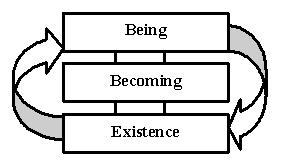
Figure 3. The Metaphysical Process
This is a construction that allows us to relate the “full story” of metaphysics: the metaphysical process in its entirety. For some reasons that we do not know, being one day (or, if time does not ontologically exist, forever) decided to become existence. Being, being pure spirit, being the absolute, was free to do that and had the power to do that. Once being reached the state of becoming, out of the billion and zillion possibilities, he/she/it chose (was forced? cajoled?) to become existence.
Existing, a term that presented a series of insurmountable difficulties either by itself or in relation to essence, when put in relation to being acquires its full meaning. Existing is true and real and here and there and everywhere and at every moment — not by itself — but in relation to being. Existing assumes all those characteristics not as a creator of all those qualities but as a participant in the essence of all the qualities of being.
We have thus reached the sanctum sanctorum of metaphysics: Being is the essence of existence — just as existence is the essence of being. Being has the existence of pure spirit. Hence, what is — alone — dialectically includes the category of existing. (Existing does not include being; existing can only be a part of being; therefore, existing is not being).
Indeed, the full story of where we are intellectually at present can be related only by realizing that the metaphysical process can also be logically interpreted starting from existence and leading to being. We would then say that existence tends to become being or even that existence creates — “invents” — being.
In this context, this writer has no comment to make in relation to this second logical possibility — except to specify his conviction that he can understand the world, not because he makes it up, but because we are made of the very same essential constitutive elements: matter, energy, and spirit. The noumenon of salmon is a chunk of existence, just as my noumenon is a chunk of existence.
The concern is to point out that, once we understand existence, being, and the link between the two entities, we can also understand the meaning of “am.” To be is what being does. Rather than keeping this discussion in the abstract, however, it might be better to relate it to human beings, specifically by inquiring whether I am indeed consciousness.
Am I Consciousness?
If I were part of being, I would indeed “be” consciousness. Instead, I am a part of existence. Therefore I have to conclude that I am not consciousness. I only exist as consciousness.
These differences can be clarified as follows. Since what exists seems to be so real, it is natural to believe that what exists is. Yet, it is not. It is not a portion of being but of existence. The table in front of me is not; it exists. Because of the lack of truth in it, the expression “what exists is” has led to jargon and gibberish that cannot be tolerated by philosophers —hence it has led to the abandonment of the metaphysical project.
To put it in sharper tones, what exists is not ontologically real. By itself, it is a figment of our imagination. By itself it could not last one second. The nominalists were and are right. What exists, exists only in relation to being. Everything, namely the reality of men, women, and the cosmos exists only in relation to being. Only being is.
However we construe the story of creation, as things stand, reduce the entire human race to one person and you realize that the human race will soon be extinct, because the individual person is not; it only exists. More precisely still, the individual person exists only because of society. It would not even exist without society, without the rest of the human race. (And society, of course, can even less exist without individual human beings.)
Rather than expounding much more on things that we do not know, on things which we do not fully understand with our mind and our powers of reasoning, let us draw the outline of a much more certain theory, the Theory of the Little I.
Toward a Theory of the Little I
If we now fully examine our opening statement, namely ”I am consciousness,” we have to conclude that the statement is false: “am” does not apply to me. The correct statement is “I exist as consciousness.”
Then the linguistic compulsion to add the preposition “as” makes me reflect that such a statement would be limiting in the extreme. Yes, I am not, I was not, and I will not be. Yes, I do exist only for a brief moment in time. But I exist much more than as consciousness alone.
Let me, therefore, give you a capsule description of a theory that I like to call the Theory of the Little I.
“I” came into this world as a Little Big Bang on December 8, 1935, at 12:00 am, the day of the Immaculate Conception, son to Luisa Capuano in Gorga and Ulisse Gorga…
Concluding Comments
Being is.
Everything else exists.
Everything exists in relation to being.
If this paper has established these three statements firmly in the mind of the reader, it has accomplished its aim: The seed of metaphysics is firmly implanted into the modern mind. The seed will grow to shed light on the past and to illuminate the future.
NOTES
- The writer is also familiar with another such case. Is saving equal to investment? In mainstream economics, it is; in Concordian economics, it is not.
- Vide Jean-Paul Sartre, Being and Nothingness [1943 (1956)].
- Perhaps it is worth spending a few words on the “reality” of sensations. This morning I woke up and heard a crackling noise. I paid no attention to it, got up and peaked though the window curtains to discover a beautiful Santa Fe morning. Obviously I went back to bed. My wife woke up and asked: “Is it raining out?” I firmly assured her that it was not raining out, whereby we both began to focus on the source of the crackling noise and we assuredly decided that it was a defect in the air conditioner. To make a long and complex story short, we established the following equivalence: sensation/I = word/noise = rain. We tested the validity of this assumption as soon as we shut the air conditioner and the noise disappeared. As to the reality of Pegasus, we hit the books and we find it there.
- To realize the full import of what our early ancestors accomplished in the field of methodology, we need to remember that by the time of Aristotle, while the principles of identity and non-contradiction were codified into a set of rules governing them — and, apart from Hegel’s challenge to the principle of non-contradiction, they have been accepted with minor variations by all subsequent systems of logic — the principle of equivalence disappeared from sight. Aristotle talked of the principle of excluded medium as the third essential principle constituting what we call the system of classical logic.
And the substitution of the principle of equivalence with the principle of excluded middle did not prove to be a permanent solution either. It served as a practical expedient for eliminating from the discourse terms that were in between such extremes as “black” and “white” These were easy choices. When the terms of distinction became rather more subtle than that, the mind could not remain satisfied with this short-cut. Thus the Renaissance mind gradually lapsed into the unbearable uncertainties of agnosticism.
When Descartes tried to reestablish a logical basis for certitude in our reasoning, he substituted the principle of excluded middle with the principle of indifference. No one seems to know when or by whom the principle of indifference was formulated. But it was well-known in the Sixteenth and Seventeenth Century. In fact, it was formally incorporated into a new system of logic by Descartes, rational logic, with these words: “If some of the matters… should offend at first sight, because I… seem indifferent about giving proof of them, I request a patient and attentive reading of the whole… for it appears to me that the reasonings are so mutually connected… that, as the last are demonstrated by the first which are their causes, the first are in their turn demonstrated by the last which are their effects” [Discourse on the Method (1637) l938, p. 60]. In live discourse, this Cartesian method is translated as: “Please, let me finish.”
Evidently dissatisfied with Descartes’ solution, Hegel substituted the principle of indifference with the principle of process — because a third principle must exist to form a system of logic. He obtained dialectic logic. And forms of dialectic logic existed already at the time of Plato. As is well known, Alfred North Whitehead did say: “The safest general characterization of the European philosophical tradition is that it consists of a series of footnotes to Plato.”
- Paul Johnson’s Intellectuals (1989) is a must read.
- But consumerism by itself is a non-issue. There is also the consumerism that puts people in contact with each other, the consumerism in which things become extensions of one’s personality. This is the consumerism that celebrates life.
- Quoted in Otto Nathan and Heinz Norden, eds. Einstein on Peace (New York: Avnet Books, 1981 ed, p. 376). From a pamphlet published by Beyond War in 1985 entitled A New Way of Thinking.
- See, Carmine Gorga “On the Equivalence of Matter to Energy and to Spirit,” Transactions on Advanced Research, July 2007 | Volume 3 | Number 2 | ISSN 1820 – 4511: 40-45 and is available at http://internetjournals.net/journals/tar/TAR2007july.pdf.
- The conflation of many meanings that makes naïve realism possible is perhaps best represented by this sentence by St. Thomas Aquinas, a sentence that he formulated to validate Aristotle’s teaching on the subject: “But ‘essence’ is used inasmuch as it designates that through which and in which a being has the act of existing” (On Being and Essence, chap. I, In Selected Writings of St. Thomas Aquinas, Robert P. Goodwin trans., NY: Macmillan, 1965). There and elsewhere, being is consistently defined as “that which is,” in any of its great variety of manifestations.
Acknowledgments
This paper is uniquely due to suggestions and comments by Msgr. George P. Graham on an earlier paper. Near total agreement with the analysis of Professor John Lukacs, At the End of an Age (2002) has been a source of inspiration and comfort in writing this paper. I would also like to acknowledge the moral and intellectual support provided over the years by Professor Franco Modigliani, a Nobel laureate in economics at MIT, in the application of the tools of analysis presented here in the difficult field of economic theory.
